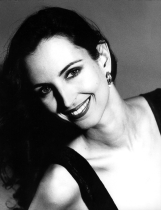Barbara Dennerlein



Especially amusing Barbara Dennerlein looks live. As the most important and most successful German jazz export the big international festival stages are familiar to her just as the clubs: the "Blue of mark" and the "Sweet of Basil" in New York, "Ronnie Scott''s club" and "jazz café" in London or the "Blue of mark" in Tokyo, festival in the USA and Canada: Montreal-, Vancouver, Toronto, Edmonton-, Victoria-jazz festival, European festivals like Hague Northsea jazz festival / Holland, Pori-Jazzfestival/Finland, Molde-Jazz/Norway, Arhus jazz festival / Denmark, Maastricht-Kortrijk-Festival/Belgium, Vitoria festival de jazz / Spain; or German festivals like Berlin, Frankfurt, Leverkusen, Nuremberg, Vilshofen, Burghausen, Freiburg, Hamburg, Hannover jazz days u.v.a. Besides, numerous broadcasting company recordings and television recordings document internationally her big results.
With her formation "Bebab" as well as in Barbara Dennerlein is celebrated Solo on this side and beyond the Atlantiks equally by critics and audience. The name "Bebab" plays with Bebop and Barbara, points to something own for which there is no established concept, no drawer. Barbara Dennerlein knows around the values of the tradition, and she is in the modern jazz, in Here and Now at home. As only a few she is able to produce the connecting lines between the different style districts (and listener's circles). The Grooves of the youth culture are familiar to her just as the hearing experiences of one generation which has grown up with the Hammond organ boom in the fifties.
There is swing and Bebop, blues, soul, Latin and radio - for Barbara Dennerlein no stiff borders, but fluent crossings. This hangs together with her taste, her talent and with her sovereignty on the instrument. A quite universal instrument and without doubt fascinates the play of Barbara Dennerlein also, because she knows like no one else how to exhaust the possibilities of her instrument fully and under the huge number of sound possibilities has discovered some which they make as a jazz musician unmistakeable.
Barbara Dennerlein is a perfectionist, however, anything but a soulless engineer. She places the biggest value of musical integration in the group. Their live tape turn out as very well well-functioning. For her CD productions she put together hand-picked occupations in which put a tread so and stylistically differently experienced musicians like Ray Anderson, Antonio Hart, Mitch Watkins, Randy Brecker, Jeff "Tain" of watt, David Murray, Howard Johnson, Frank Lacy, David Sanchez, Roy Hargrove, Bob Berg and Dennis Chambers helped.
Stimulated by the first church organ recital of Barbara Dennerlein during the brook days in Wurzburg in 1994 an intensive employment of the "queen of the instruments", the church organ began. By the masterly control of the pedal play Barbara Dennerlein succeeds in exhausting the immense sound possibilities with, among the rest, from her especially for the whistle organ to composed works fully and the instrument a little bit sluggish nevertheless to swing to bring. Thus happen on numerous great concert organs as for example of the garment house organ in Leipzig, the Klaisorgel in the Munich philharmonic concert hall, the Steinmeyer organ in the hamburger Michel, the von-Beckerathorgel in the Hanoverian market church, which Kuhn Orgel in the Essener philharmonic concert hall, the Glatter-Götz organ in the Internationally Performing Arts centre in Moscow, the Mühleisen organ in the Palace Of Arts in Budapest, the Grönlund organ of the Antarctic Ocean cathedral in Tromsdalen/Norway, the Dobson organ in the Kimmel centre in Philadelphia or the Torrence & Yeager organ of the Trinity Church in New York. The listener is kidnapped in new sound worlds, a mixture of jazz in the farthest sense with partly classical elements.
With her CD appeared in 2008 "Spiritual Movement No. Barbara Dennerlein to one of the historical-mightiest places of Germany her reverence proves 2": the imperial Wilhelm-commemorative church in Berlin. It is Barbara Dennerleins quite unique art to make the mighty whistles of a church organ about voluminous manuals and massive pedals to the stormy syncopes of the jazz pliant. "Spiritual Movement No. 2" betrays: No longer an artist is about to conquer the "queen of the instruments", rather the "queen of the church organ controls here" her instrument quite immediately as vital expression means of her musical intention. A true masterpiece which Barbara Dennerlein expels as an absolute special appearance worldwide on this instrument. With every hearing of this CD one discovers his own musical world a piece far anew. "